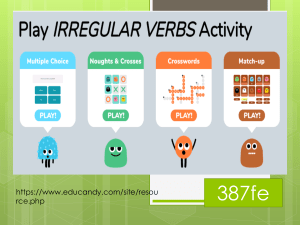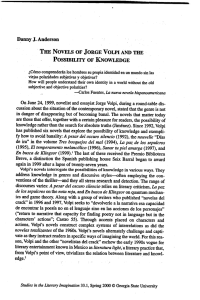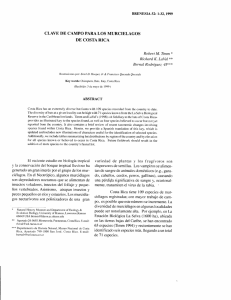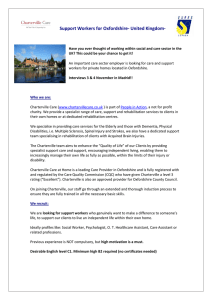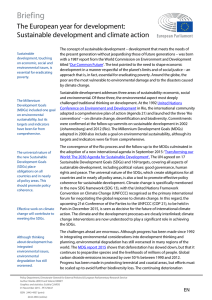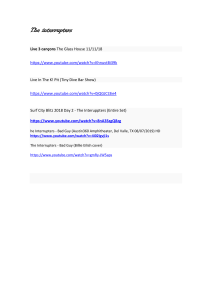Sustainable Development Goals The role of decentralization in classical and comtemporary capability
Anuncio
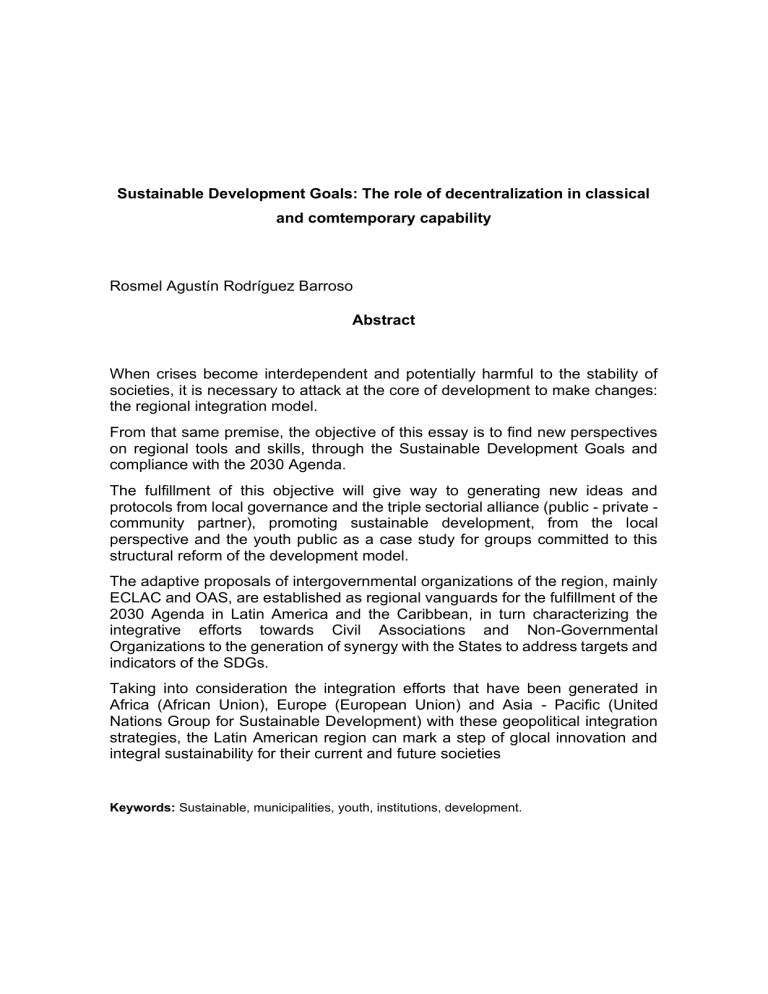
Sustainable Development Goals: The role of decentralization in classical and comtemporary capability Rosmel Agustín Rodríguez Barroso Abstract When crises become interdependent and potentially harmful to the stability of societies, it is necessary to attack at the core of development to make changes: the regional integration model. From that same premise, the objective of this essay is to find new perspectives on regional tools and skills, through the Sustainable Development Goals and compliance with the 2030 Agenda. The fulfillment of this objective will give way to generating new ideas and protocols from local governance and the triple sectorial alliance (public - private community partner), promoting sustainable development, from the local perspective and the youth public as a case study for groups committed to this structural reform of the development model. The adaptive proposals of intergovernmental organizations of the region, mainly ECLAC and OAS, are established as regional vanguards for the fulfillment of the 2030 Agenda in Latin America and the Caribbean, in turn characterizing the integrative efforts towards Civil Associations and Non-Governmental Organizations to the generation of synergy with the States to address targets and indicators of the SDGs. Taking into consideration the integration efforts that have been generated in Africa (African Union), Europe (European Union) and Asia - Pacific (United Nations Group for Sustainable Development) with these geopolitical integration strategies, the Latin American region can mark a step of glocal innovation and integral sustainability for their current and future societies Keywords: Sustainable, municipalities, youth, institutions, development. Introduction: The planet in deterioration, our existence in check. We have been for more than 250 years in a world submerged in the most drastic and accelerated changes in its history. The rapid growth of the economy and technological advances were the main reason for a paradigm shift. The economic and technological changes changed the social paradigms causing a significant and constant increase in the world population, which is estimated to be even more urbanized within the next 30 years1; The huge development in industries and economic systems as the main response to globalization caused national governments in some nations to reduce their field of action as managers of their economy, strengthening the focus on mass consumption, and limiting production only to rural areas2. For years, economic growth was established as the only way to continuously improve the prosperity of the human race on the planet. Over the years this unbridled consumerism has been shown to be not efficient in the distribution of the benefits obtained from growth, authors such as Wolfang Streeck in 2017 call this economic system unsustainable, which stops the progress that the current social paradigm carries , should be rethought. The economic growth that occurred in the last 50 years due to the rapid acceleration of the progress of the economies is unprecedented, the progress achieved is undeniable and the consequences of this development are correlated to the deterioration of the land system and the world's natural resources , being the main contributor in the changes generated at the environmental level; such as the increase in pollution levels, the loss of biodiversity, even climate change 3and 1 1 social crises, are largely attributable to human activity due to the rapid (2019) United Nations. World population prospects report 2019. Avalible https://www.un.org/development/desa/publications/world-population-prospects-2019highlights.html#:~:text=The%20world's%20population%20is%20expected,United%20Nations%20report%20launched%20today. 2 Landes, David (2003). The Unbound Prometheus: Technical Change and Industrial Development in Western Europe from 1750 to the Present (2nd ed.). New York: Cambridge University Press. 3 UNITED NATIONS ENVIRONMENT PROGRAMME (2012). GEO-5, Global Environment Outlook. Environment for the future we want. Malta: UNEP. in: acceleration of human beings during these last 50 years, seeing Mainly affected places that develop less rapidly, such as the American and Caribbean territory, demonstrating how the change has been from the first human settlements on earth, to the exploitation of resources that responds to an accelerated growth of urbanized areas4 If we delve a little into the studies of Steffen. (2015) it is identifiable that structural changes on planet earth are caused by the increase in human activity from its development and economic activity, having globalization as an ally due to the fact that development in connectivity in commerce allows for more accelerated development and consequent environmental degradation. Therefore, it is necessary to raise awareness of the way our production and consumption system is carried out, seeking the natural balance of the life cycle of the material and in line with the Sustainable Development Goals (SDG), especially with the number 7 and number 11 in search of rethinking a sustainable, more humane, ecological development that always takes into account the well-being, economic, social and ecological of the society of small and large cities, thus reducing the pace that is putting in check human life and all the species with which we cohabit. It is important not only to consider, but also to apply the SDGs in the cities of the world, since according to scientific studies and even publications made by the United Nations, if we do not influence the improvements for the Economic Systems we will have a catastrophic situation for the years after 2030, Due not only to population growth, but in addition to that, the planet currently takes a year and 7 months to regenerate the damage and what we consume in a year, generating a deficit well above what is sustainable, drastically reducing the quality and existence of natural resources and green areas, being the most affected continents with less industrial development; Therefore, if the production and consumption trends of the world population remain at this level, by 2030, “the equivalent of 2 planets Earth will be needed to sustain human life 5” and how 4 Paul Jozef Crutzen (2000) Exposes the change in the geological era caused by intense human activity on earth, closing the current geological era where life has been developing in the Holocene. 5 Global Footprint Network, (2018) would we then guarantee the stay on this planet to who do not live in the big cities? The scientist Johan Rockström and his team during 2009, established the planetary limits so that humanity continues to develop and prosper for the following generations, even the limits in which we find ourselves are far from a fatal point, but it is a warning from our planet indicating that we must rethink the way of doing things and on how our governments should manage their economy, if we place this change in 2020 in addition to the economic, ecological and social arguments already raised, a new variable is added: COVID-19 , the pandemic that has taught humanity to rethink a new normal for our society. It is important to remember at this point that the United Nations developed an action plan until the year 2030, based on 17 global objectives to act against this problem that puts human life at risk, in order to encourage governments and large capitals to modify actions and adopt them for the fulfillment of these 17 objectives. This action list is extremely important and useful if we speak of local and sustainable urban development, in a post-pandemic world where a slightly flatter structure begins to prevail, with a key player: Local governments. In recent years, it has been shown that the public policies and action strategies issued by these international organizations do not have the expected result in most of the large States because they fail to fully meet the objectives set. Therefore, the application of the SDGs must be ensured, since it is no longer enough to adapt reality to the needs of the planet, it is necessary to develop a new configuration, with normality and productivity adapted to sustainability and sustainability, which takes into account that Fundamental change decisions are promoted by International Organizations, where greater action is allowed in local governments as an effective method of sustainable socio-economic advancement and greater access of the population to be part of these dynamics. Sustainable Development Goals: The role of decentralization in classical and comtemporary capability For years, economic growth has been established as the only way to continuously improve the prosperity of the human race on the planet, but this same model of accelerated development has been the great architect of inequalities in the nations of the world, generating a serious slowdown in the process of development and urbanization as in some nations of Latin America and the Caribbean. According to the Economic Commission for Latin America and the Caribbean, the continent registers a constant decline in poverty indicators, such as the Gini Index, where 0.465 is registered throughout the region and with marked differences between countries with a positive index (such as Brazil and Colombia, exceeding 0.520) and those with a negative index (Argentina, El Salvador and Uruguay, below 0.400). Those places where, despite being the suppliers of the main raw materials worldwide, they develop at a different rate and are highly affected by the socioenvironmental ravages of the world economic system. By generating the Sustainable Development Goals (SDG) and refocusing on the alliances generated in the framework of Interregional Organizations, the lines that increase the gaps of differences begin to blur, giving way to an alternative of progress, well-being and harmonious integration, seeking areas such as ecology, from the culture and geography of each country. This approach opens the way to the territorial unit that could be the future of the world: the municipalities; combined with the demographic strategy to capitalize on this culture of sustainability: The youth population as a social actor. In this case, it will delve into success stories that can be adapted and transformed to be implemented in American and Caribbean communities, located in the current space-time context, with a planet that survives the consequences left by the COVID-19 pandemic and an evolution in the fourth industrial revolution Municipal institutions and political-social organizations as articulators and mobilizers for sustainability. For more than 50 years, global compacts have gained experience in sustainable development 6and there have been significant advances, but not with the necessary impact to promote a change in our society, so in this last decade, the SDGs should change the paradigm, but to one where local work and production is prioritized, turning this fundamental sphere into a new opportunity to act especially in the less urbanized areas of the continents and with a special focus on Latin America and the Caribbean as an element of change, with the enough material to be a participant in being the engines of change in the world, because this can not only function as a unifying element in terms of national policies according to their own cultures and belief systems, but also a change that allows locating the local in municipal and parochial institutions, in communities, in grassroots organizations, in associations, in any organization that promotes local development, that has an impact on the territory. Efforts framed in the "Forum of the Countries of Latin America and the Caribbean on Sustainable Development" 7generated by ECLAC or the "Inter-American Program for Sustainable Development"8 of the Organization of American States, show the commitment to a sustainable perspective. These initiatives are mainly integrated in the promotion of areas such as Planetary (SDG 6: Clean Water and Sanitation, SDG 13: Climate Action); Humanitarian (SDG 1: End Poverty, SDG 2: Zero Hunger, SDG 3: Health and Well-being, SDG 4: Quality Education, SDG 5: Gender Equality); and Sustainable (SDG 7: Affordable and clean energy, SDG 10: Reduction of Inequalities). The ECLAC platform has been much more oriented towards municipal empowerment work, guiding case studies in Mexico and Columbia, as well as connecting a line of work with member countries through the systematization of experiences. Methodologically, 3 stages of work have been illustrated: 6 Pactos a destacar: Estocolmo 1972, Wageningen 1976, Brundtland 1983-1987, Rio 1992 New York 1992, Kyoto 1998, New York 2000, Johanesburgo 2002, Río 20, etc. 7 < Resolution E / RES / 2016/12 of the Economic Council of Latin America and the Caribbean, on the creation of the Agency 8 Presentation of the Organization, presented under the protection of Resolution AG / RES. 2882 (XLVI-O / 16) of the 2nd plenary session of the OAS General Secretariat • Data collection, • Municipal Diagnostic Study • Generation of Good Practices Manual This is given in order to give a familiarization scheme with these objectives and their indicators, to link local problems with the pursuit of said objectives to finalize the link between local community participation and sustainable development. This will not only generate the bases for a Step by Step development in the local communities of the world, but would also contribute to the Global Pacts (from a Global perspective) a local implementation, where the planning, execution and analysis of results are closer to the community. and the real needs of society. What would be the methodology of action? The States must give more competence to the Municipalities for the development of the SDGs, provide them with a new direct action structure, promoting financing funds, exchange of experiences, making visible the work carried out, having a general supervision of the development of the SDGs in a general way . An example of the benefits of the development of local skills and sustainable development is Copenhagen, being a member of the covenant of mayors 9and prestigious international organizations with priority in local development and green policies Municipalities must prepare a local action plan based on the SDGs, with the support of specialized study centers, training support from the State and even from international organizations that are involved in the process. Once the objectives have been identified, society must be disseminated, involved and made aware, create awareness that the SDGs are, how work should be done for their development and promote that these objectives are developed not only by political institutions, but also by the organized community, where associations assume leading roles to execute projects that contribute to their fulfillment, that 9 Information on their Official Site, where they offer a compilation of results:://www.pactodelosalcaldes.eu/planes-y-acciones/resultados.html society itself is organized around their fulfillment and promotes participation and supervision of their fulfillment10 The creation of awareness in society about what sustainability means is very important, you cannot change the current course towards a model that is committed to sustainability without first creating a new vision around these precepts and new ways of life product of the impact global COVID-19, it is important that we all have access to this information, and make young people educate themselves around this change, including public debates; forming a society that understands that there is a situation and must act together to contribute to the implementation of a system that is committed to sustainability, development, progress and the stability of humanity. Youth as a guarantee for the future The territorial sense of the Municipality, as the mainstay of glocal development for the fulfillment of the SDGs, has framed its efforts in raising awareness of the objectives and in the pedagogical approach of its applicability in the environment. From this enclave, organizations such as the International Youth Organization have presented initiatives to frame the effort and empowered youth vocation as fuel for the massification of the SDGs. Under this reading, initiatives such as "Implementation of the 2030 Agenda in the key of Youth" 11stand out where a series of proposals were presented such as the implementation of a series of adaptive indicators of the SDGs for youth activism, strategies for greater participation in local efforts and the creation of an “Alliance for Youth” that allows joining efforts for its applicability, based on previous agreements such as the World Youth Conference (2014), the First World Forum on Youth Policies (2014) and the participation of youth conglomerates. in spaces like ECOSOC. All these Global Compacts and global goals are meaningless if Youth is not actively involved. Young people must have a leading role in the development of 10 In the Latin American region should carry a methodology focused on local traditions and customs, hand in hand with the NGOs and International Institutions that make life in the continent, thus demonstrating the importance of involving the population in a real way., 11 Document presented at the Regional Forum for Sustainable Development, organized by ECLAC in 2018. the plans outlined, because they are the future of our species and must have knowledge of how we are working to have the best possible future, it is necessary to remember the population age of each one of the areas where these projects are to be implemented, because in the less urbanized areas most of the population is young, of productive age, and with the firm purpose of guaranteeing a better world. Within the framework of ECLAC, the "Declaration of the Youth of Latin America and the Caribbean" was presented, which created a guideline for youth work in the region, combined from the effort of civil society as a guarantor of social cohesion and the states (national and local) to promote governance in accordance with the spirit of the 2030 Agenda. From there, there is an established link with sustainable work to be substantially capitalized as evidence of a defined work horizon between civil associations and SDGs in Latin America. It is necessary to invite organized youth and encourage the non-organized to work in the development of the SDGs, promote spaces for participation, where leaders will continue with the work started based on their generational vision and continue the work cycle generation after generation, since sustainable development is something that must be continuous, especially after the crisis generated by the pandemic caused by the coronavirus, Highly local territories may be an enclave for the development of a new postpandemic reality, while optimal regional plans and strategies for sustainable development are conducted, which in turn will bring enrichment and protection of the cultural, one more way Humanized of "Glocalization" For this, it is necessary to recall the success stories and their application and adaptable methodology in other settings such as the African one. The case of Sao Paulo and other municipalities with non-urbanized areas in Brazil12 have been the most effective and applicable models, which is why it is suggested as a methodology for African cases and the impact of COVID-19 in the region. 12 The World Organization of United Cities and Local Governments. Midiendo la agenda global en los municipios: El “Mandala ODS”. Available in: https://www.uclg.org/sites/default/files/el_mandala_ods.pdf Suggested methodologies for the implementation and monitoring of efficient municipal management in line with the SDGs The “Mandala of the SDGs” consists of a strategy developed by the Confederation of Municipalities of Brazil, it is one of the many tools that UCLG (United Cities and Local Governments) has used recently in the learning sessions and that associations have been of importance nationals of that country, being an example of how in the middle of the municipality the implementation of the process can be changed in the traditional way, to a more balanced and flat way and in line with the 4th industrial revolution and the new vision of world society Another local process of great importance and interest for the desirable objectives in the continent. It is developed by the Associations of Districts (LKT), Cities (DST) and German Municipalities (DSGB) in conjunction with the Bertelsmann Foundation and the Ministry of Territorial Research (BBSR). 13This method, unlike the Mandala applied by the South Americans; The 17 SDGs function as a starting point for all the elements and indicators to be applied and evaluated. Formally, each of the Sustainable Development Goals has three or four assigned indicators, all of this derived from an analytical process that uses a systematic and multi-level approach. This is possible as long as most of the indicators maintain a municipal database updated periodically, translating the availability of information and access to data from these municipal administrations as an advantage for benchmarking and clustering according to local characteristics and needs. Despite this, not all the indicators they use are based on data collected directly in the municipalities.Through the municipal monitoring process, approximately 10% of the indicators require data from the national or regional statistical centers of the nations. in which they are applied. These local indicators (Driven and supported by national data and with community participation) facilitate alignment with the predetermined indicators of the SDGs, and allow comparing the efforts of different regions, taking into account their customs and needs, generating public policies not only more human, applicable to diverse communities, sustainable and enduring 13 The World Organization of United Cities and Local Governments. Midiendo la agenda global en los municipios: El “Mandala ODS”. P.8 This format seeks to adapt to any local development model, for 3 basic reasons: 1.- The eclectic nature of the indicators proposed in the Mandala, favors the social and ethnic integration of social groups by generating participation and cultural recognition of their reality; 2.- Strengthens the link between various public, private and community organizations for solving problems, articulating efforts and wills to generate social cohesion; 3.- It combines good practices from a glocal perspective, starting from the particularity of the territory towards the global perspective of the situation for its resolution. The Mandala is an innovative tool in its style, but it must be remembered that despite being the one recommended in this small study, due to its high degree of effectiveness, it is not the only methodology to monitor the process of locating and municipalizing the Objectives of Sustainable Development, but it is a tool that with adaptation to the geographical environment, population density and Cultures within African, can be applied with a high hope of effectiveness. Observing it beyond borders, when developing the SDGs from the territorial level, understanding municipal actors and grassroots organizations, it is remarkable that the work carried out can be shared with their counterparts anywhere in the world, because there are 17 general objectives, perhaps implemented in a different way due to the particularities of each region, such as in this case the African one, but finally the same due to its final objective, for which the international link between local, regional and national actors promotes efficient cooperation, creating new networks between local leaderships, flourishing and expansion of multi-culture and if they are channeled in a good way, taking into account the common objective: sustainable development, we will be able to bet on a planet with higher rates of interconnection, overcoming barriers imposed between The cultures. 2020 and the new normal: Towards sustainable local development and a refocusing of the SDGs?: Latin America and the Fourth Industrial Revolution Latin America offers a challenge in applying the Sustainable Development Goals. The challenges of sustainability and local territorial empowerment in the region have been tangible evidence of the panorama that must be faced in order to achieve the expected development. Latin America and the Caribbean have great challenges to achieve a refocusing of their sustainable local development, from the perspective of the SDGs 14(especially oriented in its 5 Areas): 1.- Area of Justice (Obj. 16): The challenge of democratic institutions and justice in the responsibility to appease the climate of ethnic conflict that is pressing in places of great need; 2.-Area of the Planet (Obj. 6, 12,13,14,15) in finding approaches for the sustainable use of natural resources that guarantee a balance between the coverage of basic needs with the preservation of the environment, fauna and flora in the localities; 3.- People Area: (Obj. 1, 2, 3, 4, 5.) Develop strategies to achieve schooling and food fulfillment, as well as major initiatives such as gender equality (especially in cases such as trafficking children, and practices condemned internationally as female cutting, as the attack on structural poverty in the region; 4.- Prosperity Area (Obj. 7, 8, 9, 10, 11) Promote dynamics of local entrepreneurship, based on the experience of productive clusters and taking advantage of local potentialities to project a relevant role of the national economy. From there, there is the glocal economy alternative as a projection of a sustainable alternative; 5.- Association Area: (Obj. 17) promote awareness of the SDGs in various social groups as an enclave for the promotion of individual and collective development, from the replication of good practices as well as public, private and community support for the generation of a vision of organized community. What would be the technological role to sustain the rise of the Fourth Industrial Revolution? The opportunity to recognize, integrate, re-educate and unite communities and cultures, from the reading of an integrated focus of action for the construction of practices that generate a pivot of governance and a selfadministered maneuver. This is oriented from our case studies (ECLAC and OAS) as platforms for action: ECLAC directed towards good practices of Governance and Good Governance, and OAS towards the empowerment of civil society organizations towards the applicability of the 2030 Agenda. 14 Dambisa Moyo. When aid is the problem: there is another way for Africa The regional paradox shows us the responsibility of local governance as an indispensable tool for the integral progress of the sectors. Today the challenge is to generate the conditions of accompaniment and support in the sustainable scope of its capacities such as the use of its resources to combine the new effort for a more solid continent and committed to the well-being of its members. ECLAC and OAS: The Unifying Proposal of a Sustainable Continent. Among the protocols presented (“Forum of the Countries of Latin America and the Caribbean on Sustainable Development” and “Inter-American Program for Sustainable Development”) show similarities in perspectives and divergences that broaden the playing space to capitalize on the ODS effort in the continent. The great similarities between the proposals are located in the following parameters: 1. The integrating context between the public sector, the private sector and the socio-community sector as an enabling foundation for sustainable development. 2. The reinforcement of various international protocols and conventions adhered to by other intergovernmental organizations to complement the glocal view of the 2030 Agenda. 3. Link the major global problems in particular efforts that help correct present problems and potential situations for various social groups. These similarities are seen as a cyclical effect: These fundamentals gave way to the Agenda and at the same time, the Agenda is linking international efforts to harmonize its implementation. A cycle is exercised where the vision of a selfsustaining society is specified to guarantee a broad future for new generations. The differences that both platforms present are based on 3 variables: priority objectives, target social groups, and social intervention mechanisms that offer response capacity. The "Forum of the Countries of Latin America and the Caribbean on Climate Change" becomes more involved in the maneuvering capacity of the States and Public Power Institutions, with the ability to guide other instances to synchronize actions for the effective fulfillment of the 2030 agenda. The emphasis on its adaptation is oriented more on the parameters established in the High-Level Political Forum on Sustainable Development, held within ECLAC, during 2019. There, priority was given to the following list of objectives where priority will be given the work of this forum: • SDG 4: Quality Education • SDG 8: Decent Work and Economic Growth • SDG 10: Reduction of Inequalities • SDG 13: Climate Action • SDG 16: Peace, Justice and Strong Institutions • SDG 17: Partnership to achieve the SDGs The mechanisms of social intervention are located in community support strategies, diagnostic studies with local compliance reports and protocol development of good practices for the sustainable compliance of the municipality. The "Inter-American Program for Sustainable Development" is focused on intensifying the work with Civil Society organizations. Although it is also protected by the will of the Member States, the difference with the ECLAC document is to break with the tutelary role and generate a link between intergovernmental organization and civil society organization, established from a macro focus of cohesion work Social. In the framework document, they establish the priority SDGs to work under this approach: • SDG 6: Clean Water and Sanitation • SDG 7: Affordable and Clean Energy • SDG 11: Sustainable Cities and Communities • SDG 15: Life of Terrestrial Ecosystems • SDG 16: Peace, Justice and Strong Institutions This program conceives a more environmental and oriented priority in the spatial habitat of each environment. The mechanisms of social intervention are based on the development of training offers and financing of local projects to social organizations. In addition to promoting effective projects to strengthen development benchmarks. Conclusions As both regional guidelines establish, based on inclusive growth and sustainable development, it is possible to generate from the global scenario left by the recent COVID-19 pandemic opens not only a window, but the door to a new way of doing things. Throughout the world, it opens the possibility to reduce the gap that massifies and extends the possibilities of nations, at present and in the near future, the focus will be more clearly placed on municipalities, on the closest primary work cells to the population and their needs. Despite the fact that in many countries of the continent the figures are not the most optimal, they show a clear result: Latin America wants and can evolve and understanding not only its culture, geography and ethnography is not enough, that is why the SDGs are elemental keys to finally bring improvements and tools to the continent. From there, the local universe is made from small triumphs of organization, cohesion and social empowerment that are associated with each other and is integrated with the mechanisms of youth participation as a mechanism of generational extension of a sustainable culture. By analyzing the success stories and the way in which methodologies for the application of the SDGs have been implemented in other countries of the world, it is clear that in hostile areas, with a high rate of instability, optimal development and application of the SDGs can be achieved. Just as Brazil did with its innovative method of the “mandala of the SDGs”, generating effective and tangible results with its methodology that, transforming it and adapting it to the regional reality, can be a powerful and useful tool for the transformation of the continent, finally adapting to the fourth industrial revolution with all that the technological era entails and finally generating possibilities for post-pandemic sustainable development. It is recommended not to leave aside the main capital that any municipality has: Human Capital, especially youth, in their hands is a correct management and friendly development of all the policies and strategies that are envisioned and will be the prevailing trend at that level. At the end of the pandemic, finally, the planet is in check, and it is in the hands of each continent, organization, nation, municipality and organized community, to be part of the change that will make this a sustainable planet. References • Ciudades y Gobiernos Locales Unidos Midiendo la agenda global en los municipios: El “Mandala ODS”. Available in: https://www.uclg.org/sites/default/files/el_mandala_ods.pdf • Crutzen, Paul J. y Eugene F. Stoermer. (2000), “The ‘Anthropocene’”.Global Change Newsletter, núm. 41, pp. 17-18. • ECOSOC. Development Cooperatiom Forum. (2016) La Localización de la Supervisión y la Revisión de la Cooperación. Available in: https://www.un.org/en/ecosoc/newfunct/pdf15/dcfuganda_ll_monitoring_es.pdf • FOUCAULT M. 1992. Microfísica del poder Edición y trad.J. Varela et al. La Piqueta. Madrid • Fundación Corresponsables. (2017). Los Objetivos de Desarrollo Sostenible (ODS) o cómo aterrizar la utopía de un mundo mejor. Dossier. Available in: https://www.corresponsables.com/download/DOSSIER_ODS_IBERO.pdf • Landes, David (2003). The Unbound Prometheus: Technical Change and Industrial Development in Western Europe from 1750 to the Present (2nd ed.). New York: Cambridge University Press. • Maddison A. (2003). The World Economy: Historical Statistics, Paris, OECD. • Moyo. D. (2011) Cuando la ayuda es el problema. Hay otro camino para África. Prólogo de Ramón Gil-Casares. Gota a Gota. Madrid. • Pacto de los alcaldes para el Clima y la Tecnología, Planes de Acción. Available in: https://www.pactodelosalcaldes.eu/planes-y-acciones/planes-deacci%C3%B3n.html • Presidencia de Argentina. Manual para.la adaptación local de los objetivos de desarrollo sostenible. Available in: https://www.odsargentina.gob.ar/public/documentos/seccion_publicaciones/prov muni/manual_de_municipios.pdf • Programa de las Naciones Unidas para el Desarrollo PNUD.(2019). Usando datos para medir los ODS en municipios. Coordinación de la Unidad de Desarrollo Humano, PNUD Brasil. Available in: https://www.undp.org/content/undp/es/home/blog/2019/using-data-to-measurethe-sdgs-in-municipalities.html • Steffen, W(2015) Planetary Boundaries: Guiding human development on a changing planet • Streetlight, W (2017) How will capitalism end? • The World Organization of United Cities and Local Governments. Midiendo la agenda global en los municipios: El “Mandala ODS”. Available in: https://www.uclg.org/sites/default/files/el_mandala_ods.pdf • United Nations. Agenda 2063: Africa We Want. Available in: https://www.un.org/en/africa/osaa/pdf/au/agenda2063.pdf • United Nations (2012). Environment Programme GEO-5, Global Environment Outlook. Environment for the future we want. Malta: UNEP. • United Nations. (2019). World population prospects report 2019. Available in: https://www.un.org/development/desa/publications/world-populationprospects-2019highlights.html#:~:text=The%20world's%20population%20is%20expected,Unit ed%20Nations%20report%20launched%20today. • VILCHES, A. y GIL, D. (2003). Construyamos un futuro sostenible. Diálogos de supervivencia. Madrid: Cambridge University Press. Capítulo 4. • VILCHES, A., GIL PÉREZ, D., TOSCANO, J.C. y MACÍAS, O. (2014). «Biodiversidad» Links of Reference • https://www.cepal.org/es/temas/objetivos-desarrollo-milenio-odm • https://www.cepal.org/es/proyectos/municipalizacion-odm • https://www.cepal.org/MDG/noticias/paginas/5/44335/MDGs_LaPlata_Moron_ Rosario.pdf • https://www.cepal.org/MDG/noticias/paginas/0/44330/Cochabamba.pdf • https://www.cepal.org/MDG/noticias/paginas/8/44338/Resumen_Valparaiso.pdf • https://www.cepal.org/MDG/noticias/paginas/6/44336/Narino_final.pdf • https://www.cepal.org/MDG/noticias/paginas/4/44774/estudio_de_caso_Mexico .pdf • https://www.cepal.org/MDG/noticias/paginas/4/44494/Estudio_de_Caso_Brasil. pdf • https://www.cepal.org/es/temas/innovacion-social • https://www.cepal.org/es/temas/agenda-2030-desarrollo-sostenible • https://www.cepal.org/es/temas/agenda-2030-desarrollo-sostenible/foro-paisesamerica-latina-caribe-desarrollo-sostenible-seguimiento-regional-la-agenda2030 • https://www.cepal.org/es/documentos/700xxxvi-resolucion-mexico-la-que-secrea-foro-paises-america-latina-caribe-desarrollo • https://www.un.org/ga/search/view_doc.asp?symbol=E/RES/2016/12&referer=h ttps://www.google.cl/&Lang=S • https://repositorio.cepal.org/handle/11362/44551 • https://www.cepal.org/sites/default/files/styles/content_big/public/static/images/i nfografia_foro_alc_es_20_09_2016-page-001.jpg?itok=ZesNi-3i • https://www.cepal.org/es/publicaciones/45336-la-agenda-2030-desarrollosostenible-nuevo-contexto-mundial-regional-escenarios • http://www.oas.org/es/acerca/secretarias.asp • http://www.oas.org/es/sedi/dsd/GIRH/default.asp • https://www.aciamericas.coop/IMG/pdf/ricardodominguez.pdf • http://www.oas.org/en/sedi/pub/PIDS_ESP_2017.pdf • https://comunidades.cepal.org/ilpes/es/grupos/discusion/el-rol-de-lasjuventudes-y-los-objetivos-de-desarrollo-sostenible • https://drive.google.com/file/d/1rD52UNhBX9_bRhwaMSwcPnoLKC7Bbwjv/v iew • https://www.cepal.org/es/temas/juventud • https://www.cepal.org/es/eventos/seminario-virtual-juvelac-juventud-objetivosdesarrollo-sostenible-ods • https://foroalc2030.cepal.org/2019/sites/foro2019/files/america_solidaria_agend a_evento_paralelo_foro_cepal_2019_15042019.pdf • https://foroalc2030.cepal.org/2018/sites/foro2018/files/presentations/oij__reunion_reflexion-foro_regional_de_desarrollo_sostenible_2018.pdf • https://comunidades.cepal.org/ilpes/es/grupos/evento/encuentro-de-joveneslideres-en-america-latina-y-el-caribe-por-los-ods • https://repositorio.cepal.org/bitstream/handle/11362/14987/1/S0020113_es.pdf


